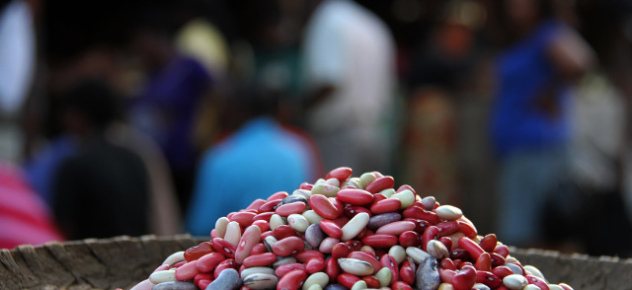
Thirty “elite” lines of beans show tolerance to temperatures 4 degrees Centigrade above the crop’s normal “comfort zone.” Credit: Stephanie Malyon / CIAT
Alleviating fears that bean production will take a big hit from global warming, CIAT researchers have identified about 30 “elite” lines showing tolerance to temperatures 4 degrees Centigrade above the crop’s normal “comfort zone.” This research represents a major contribution to the CGIAR Research Programs on Grain Legumes and on Climate Change, Agriculture and Food Security (CCAFS).
According to computer modeling conducted by Center climate experts in 2014, the heat-tolerant beans can counter most of the negative impacts of rising temperatures. Based on analysis using 19 global climate models, they concluded that, with current varieties, the area suited for bean production will have shrunk up to 50% by about 2050. With heat-tolerant beans, the reduction will be only 5%, even assuming conservatively that the tolerant beans can handle a temperature rise of only 3 degrees.
“In some parts of Africa and Latin America, farmers adopting the heat beaters will actually be able to expand production on land where it’s normally too hot for beans,” said Andy Jarvis, a CGIAR climate expert. “These lines represent a major breakthrough in buffering a vital protein source for the poor against the worst-case climate change scenario of a 4-degree temperature rise.”
Hopes grow for climate-proof beans http://t.co/Sri4Kqd8hR
— BBC News (World) (@BBCWorld) March 25, 2015
Scientists identified the heat-tolerant beans among 1,000 advanced lines tested at two locations in Colombia. For years, they had improved the lines for tolerance to drought and low soil fertility. But then in 2012, CGIAR climate experts published results suggesting that in the coming decades the biggest threat to bean production worldwide will be heat stress.
More recent research has shown that in Latin America rising temperatures will have especially severe impacts on beans in Nicaragua, Haiti, Brazil, and Honduras. In Africa, bean crops in Malawi and the Democratic Republic of the Congo are the most vulnerable, followed by Tanzania, Uganda, and Kenya. In Nicaragua, 60% of the bean crop will be hard hit by rising temperatures.
These findings prompted bean researchers to test the elite lines under extreme temperatures. Beans are highly sensitive to heat, and the varieties that farmers currently grow do not yield well under night temperatures over 18 or 19 degrees Centigrade. Higher temperatures drastically reduce seed fertility, leading to lower grain yields and quality. In the heat-tolerant lines recently identified, pollen from bean flowers remains viable even with a temperature increase of up to 4 degrees.
“Not until we turned up the temperature, did we realize that so many lines selected for other stresses are also highly tolerant to heat,” said Steve Beebe, leader of CIAT’s Bean Program.
Many of the tolerant lines come from crosses between the widely grown common bean and a lesser known cousin called tepary bean, which was domesticated in the arid climate of the southwestern USA and northern Mexico, and is more tolerant of these conditions than any other grain legume.
“The discovery of heat-tolerant beans illustrates very well why it’s so important to safeguard and experiment with plant genetic diversity,” said Ruben Echeverría, CIAT’s director general. “The seeds in our genebank are a vital resource for enabling farmers in developing countries to cope with the impacts of climate change.”
30 new strains of heat-tolerant beans may thrive with increasing temperatures. http://t.co/Y5NFiQZI0m #science pic.twitter.com/UMsWrvh8ns
— Scientific American (@sciam) March 25, 2015
Some of the heat-tolerant lines identified by Beebe and his team have also undergone genetic improvement for iron content. Deficiencies of this essential micronutrient afflict one out of every two preschool children and pregnant women in developing countries, making them highly susceptible to anemia and compromising children’s growth and cognitive development.
To provide a new measure for combating micronutrient malnutrition, CGIAR researchers embarked more than a decade ago on a pioneering program of crop improvement. The iron content of bean lines resulting from this work is double that of varieties currently grown.
Beans contribute to the daily diet of more than 400 million people across the developing world. They are a highly nutritious food, providing an inexpensive source of protein, fiber, complex carbohydrates, vitamins, and micronutrients. As such, beans strongly reinforce food and nutrition security among low-income consumers, while also reducing the risk of cardio-vascular disease and diabetes.
“A couple of years ago, when climate change experts warned that rising temperatures could devastate bean production, we were asked how this would affect the spread of high-iron beans,” said Beebe. “Now, I’m confident we can deliver more iron-rich beans that are also heat tolerant, offering even greater benefits than expected, because these beans can be grown more widely.”